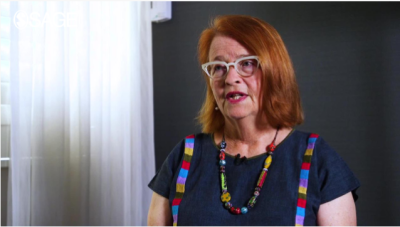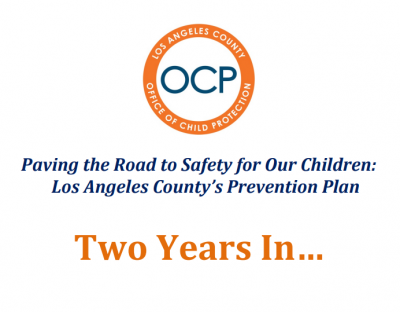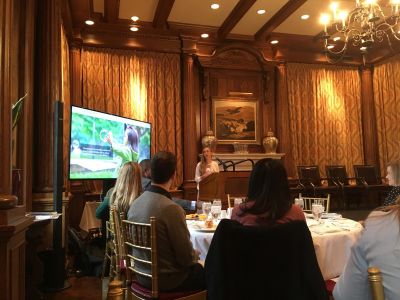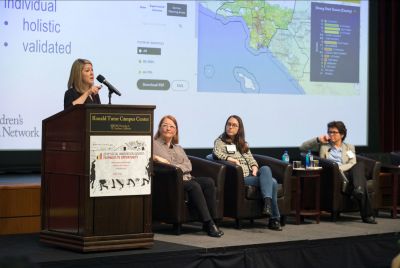Why Doesn’t the U.S. Have an Accurate Count of Child-Abuse Deaths?
Last week, The New Yorker published a story about state to state variations in accurately and consistently documenting child-abuse related deaths. Although the National Child Abuse and Neglect Data System estimated 1,720 children in the United States died due to abuse and neglect in 2017, the journalist documents numerous reasons this number should be questioned. Emily Putnam-Hornstein, Principal Investigator at the Children’s Data Network, was quoted saying “The numbers could easily be three times or four times higher than what’s reported.” In California, we know that at least 1,469 children have died from maltreatment between 2008 and 2018. Putnam-Hornstein goes on to explain, “The death itself may be a rare occurrence, but the circumstances around it are usually far from rare. We can look at those circumstances to see what went wrong and learn how child-protection agencies can conduct better investigations and make better decisions.” Please visit our project page, Population-based, Birth Cohort Studies of Child Deaths Before Age 5, for a summary our work related to child fatalities.
Moving Families from a Hotline to a Helpline receives a Gold Eagle award
We are proud to announce that the Moving Families from a Hotline to a Helpline project has been awarded this year’s Gold Eagle, the LA County Quality and Productivity Commission’s highest honor. The project applies Lean Six Sigma principles to streamline linkage between DCFS families and preventative services and supports.
Conceptualized and implemented through a unique partnership between the LA County Board of Supervisors (BOS), Office of Child Protection (OCP), Department of Children and Family Services (DCFS), County Counsel, Mental Health, Registrar-Recorder/County Clerk, and the Children’s Data Network (CDN), the project has tripled the number of families connected to prevention supports and cut enrollment wait times in half. These outcomes are promising. All involved appreciate the recognition for this innovative solution to strengthening and empowering vulnerable families.

Data-Driven Decision-Making in Macro Practice Social Work
Dr. Jacquelyn McCroskey, endowed professor at the USC School of Social Work and the Co-Director of the Children’s Data Network, recently sat down with Rachael LeBlond from SAGE Publishing for an interview about the importance of data-driven decision-making in macro-level practice in social work.
As opposed to direct interaction with clients to address individual problems, macro practice social work aims to improve the systems with which clients interact. As such, macro practice involves various organizations and key players, including social workers, attorneys, doctors, school teachers, and counselors. Keeping these key decision-makers on the same page is crucial to protecting and supporting vulnerable children and families. “[Data] serves almost as a translator between people with different roles in the system. It creates a common language,” notes Dr. McCroskey. In this way, and many others, data can facilitate real change in the lives of vulnerable children and families.
Click here to watch the interview and learn more about the ways data can inform policy and practice.
Latest News on Dr. Megan Finno-Velasquez
The CDN would like to congratulate researcher Dr. Megan Finno-Velasquez on receiving one of the 2019 Hispanic Research Scholars Program Awards, sponsored by the National Research Center on Hispanic Children and Families. In collaboration with the Center investigators, she will conduct research on early childhood support for Hispanic children. Dr. Finno-Velasquez has also been appointed as Director of Immigration Affairs for the New Mexico Children, Youth, and Families Department. Over the next year, she will develop an immigration unit designed to improve the policies and practices that support immigrant and refugee children along the border and throughout New Mexico.
Latest News on Tenia Davis
CDN fellow, Tenia Davis, was selected for the Center for Innovation in Child Maltreatment Policy, Research, and Training (CICM) 2019 LEAD predoctoral program and recently attended the three day summer institute held at Washington University in St. Louis. The program is designed to provide education and training opportunities to predoctoral scholars interested in pursuing a PhD in social work, public health, or public policy areas. The CDN would like to congratulate Tenia on her acceptance into the program and look forward to leveraging her knowledge and experience to inform program and policy development in the area of child maltreatment.
Paving the Road to Safety for Our Children: Los Angeles County’s Prevention Plan Two Years In…
Two years ago, the Los Angeles County Office of Child Protection (OCP) released a report entitled Paving the Road to Safety for Our Children: A Prevention Plan for Los Angeles County. The report was OCP’s “blueprint for partnering with the Los Angeles region’s diverse communities to coordinate and expand existing prevention-focused networks to further strengthen families, prevent child maltreatment, and reduce unnecessary burdens on the child welfare system.” We were proud to collaborate with the Department and First 5 LA to help achieve goals outlined in the original report. The OCP released a report Paving the Road to Safety for Our Children: Los Angeles County’s Prevention Plan: Two Years In… that detailed activities and developments that have been accomplished. We supported efforts including: (1) the identification and mapping of over 500 prevention-related networks; (2) the creation of an initial set of countywide prevention metrics that measure the County’s efforts to support strong children, families, and communities; (3) the development of plans to create a universal home-visiting system; and 4) conducting a comprehensive fiscal analysis of early care and education programs across the county. We look forward to supporting the OCP, County Departments and community partners in work to strengthen families and protect children.
California Strong Start Index
The CDNs’ Strong Start Index was highlighted in the newest issue of insights, a publication by the California Child Welfare Co-Investment Partnership. Focusing squarely on Adverse Childhood Experiences (ACEs), the issue identifies the Strong Start Index as a valuable resource for identifying areas in need of greater supports to bolster family resilience and well-being, an intervention key to mitigating negative outcomes.
We are thrilled to be included in the discussion about the need for policies and practices to serve the state’s most vulnerable children. Please visit www.strongstartindex.org to learn more about how communities are using it to facilitate equitable investment.
Friends of the Children fundraising breakfast
CDN postdoctoral scholar, Andi Eastman, presented at the annual fundraising breakfast hosted by the award-winning non-profit Friends of the Children. Dr. Eastman shared insights from her dissertation relating to two-generation child protective services involvement for young mothers in foster care and their children, work supported by the Conrad N. Hilton Foundation, who was also in attendance. Other key stakeholders included the Reissa Foundation, California State Senator Holly Mitchell, and Director of the Los Angeles County Office of Child Protection, Judge Michael Nash. Dr. Eastman’s presentation reinforced the interconnectedness of mothers and children, highlighted opportunities to address barriers to service delivery, and provided evidence that these families are doing better over time. The CDN is grateful for the opportunity to share our work with the community and influential stakeholders.
2019 Price Social Innovation Summit
Last week, the CDN had the privilege of being represented by Drs. Regan Foust and Jacquelyn McCroskey at the Price Social Innovation Summit: Pathways to Opportunity. The conference was built around the premise that the zip code in which one grows up should not be a primary determinant of life outcomes. The Price Center held the conference to explore new approaches to increasing opportunity for low-income residents through education, policies to support strong and stable families, and access to jobs for justice-involved individuals.
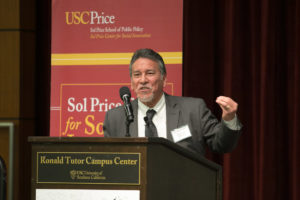
Jacquelyn and Regan were joined by panelists Linda Aragon, Director of the Los Angeles County Department of Public Health’s Division of Maternal, Child, Adolescent Health; Armando Jimenez, Director of Measurement, Learning, & Evaluation for First 5 LA; and Carrie Miller, Assistant Executive Director of the Office of Child Protection. The panel discussed how data partnerships are working to strengthen families. Carrie focused on LA County’s recent plan — Paving the Road to Safety for Our Children: A Prevention Plan for Los Angeles County — that engages the community in prevention efforts to strengthen families and reduce the need for intervention from child protective services. Linda detailed the work the County Department of Public Health has done to expand home visiting programs and Jacquelyn described the efforts the Policy Roundtable for Child Care and Development has done to expand access to ECE.
Regan presented the California Strong Start Index, a new tool developed by the CDN and the First 5 Association to help communities more efficiently and equitably allocate resources. By organizing information available on the birth record, the California Strong Start Index summarizes the conditions into which children are born in California. Mapping that information facilitates the identification of communities where additional services and supports could promote equity. The Index also has potential to better steward pubic funds and standardize community needs assessments.
The CDN was grateful for the opportunity to share how we are using data to strengthen families and to learn from our colleagues as they pursue to same goal. Please refer to this Policy Brief for more information.
Congratulations!
CDN Doctoral Student, Eunhye Ahn, has been accepted as a fellow for the Data Science for Social Good Summer Fellowship at Imperial College London, in collaboration with University of Chicago. Selected from among 750 applicants, Eunhye’s acceptance underlines the great promise she has shown to use data science to make a social impact in the world throughout her career. We wish her all the best on her learning adventure, and are excited for her to leverage her knowledge and experience here at the CDN, and beyond.


